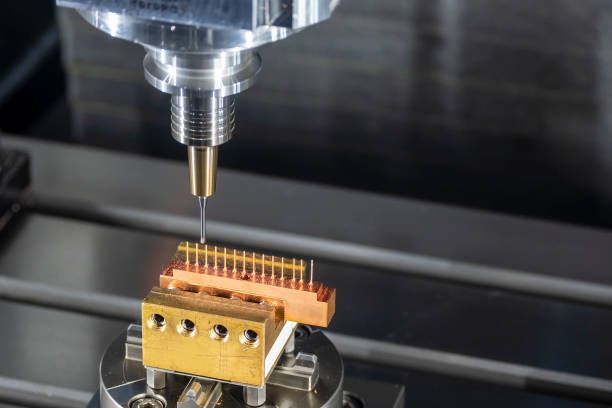The electrical discharge machining (EDM) process as we know it today began with the observations of Joseph Preistly in 1770. In his experiments, he noticed that electrical discharges removed material from the electrodes. Also known as electrical discharge machining.
In the 1940s, two Soviet researchers, the Lazarenkos, developed a machining process that formed the basis of modern wire and small hole EDM. Eventually, practical EDMs emerged, using more powerful pulse generators, automatic repetition and a steady flow of dielectric fluid to control the process.

The basic process of spark erosion is really quite simple. Between two electrodes (solid electrical conductors) an electrical discharge (spark) is created. The tool electrode is usually called the electrode and the workpiece electrode the workpiece. The spark is the visible evidence of the flow of electricity. The spark generates intense heat, reaching temperatures of 8000-12000°C, melting almost any conductive material. These rapid, repeated electrical discharges occur in a very small gap between the two electrodes, which never touch each other. Machine control adapts to maintain a constant, stable distance as electrical discharges occur up to millions of times per second.
Sparks are subject to very precise control and positioning, thus only affecting the surface of the material. Electrical discharge machining usually does not affect the heat treatment below the surface. Both tools and workpieces are immersed in a dielectric (non-conductive) liquid, usually deionized water.
Sparks are always generated in the dielectric fluid. The conductivity of deionised water is strictly controlled, creating an ideal environment for the erosion process. Deionised water can also play a cooling role during machining and wash away small corrosive metal particles.
Electrical discharge machining is considered a non-traditional machining method because it uses discharge to remove materials from the workpiece. This is completely different from traditional machining methods that use mechanical force to remove materials, such as drilling or grinding.
Wire EDM, also known as electrical discharge machining, wire cutting, EDN cutting, wire cutting, wire sintering, wire erosion, wire corrosion, wire cutting discharge machining, and cheese cutting machine discharge machining.
Wire electric discharge machining (WEDM) uses metal wires to cut or shape workpieces, usually conductive materials, using fine electrode wires that follow precise programmed paths. The electrode diameter is usually between 0.004″ – 0.012″ (0.10mm – 0.30mm), but smaller or larger diameter electrodes are available.
During the wire EDM process, there is no direct contact between the wire and the workpiece, allowing machining to take place without distorting the path of the wire or the shape of the material. To achieve this, the wire is charged very quickly to a desired voltage. The wire is also surrounded by deionised water. When the voltage reaches the correct level, a spark jumps across the gap and melts a small part of the workpiece. The deionised water cools and flushes the small particles out of the gap.
The hardness of the workpiece material does not affect the cutting speed. Extrusion dies and punches are very often machined by wire EDM.